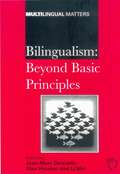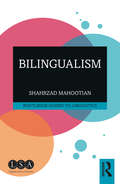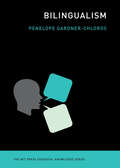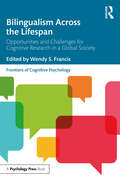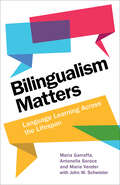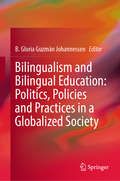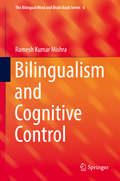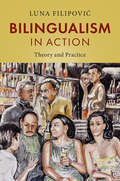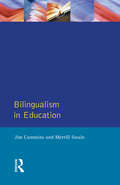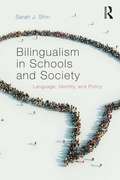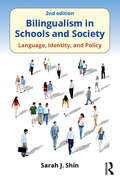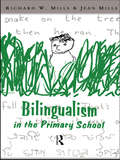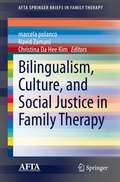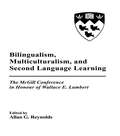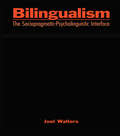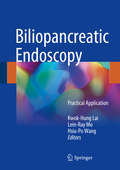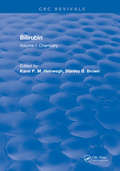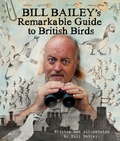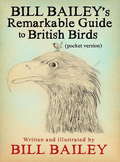- Table View
- List View
Bilingual: Life and Reality
by Francois GrosjeanWhether in family life, social interactions, or business negotiations, half the people in the world speak more than one language every day. Yet many myths persist about bilingualism and bilinguals. In a lively and entertaining book, an international authority on bilingualism explores the many facets of life with two or more languages.
Bilingualism
by Alex Housen Jean-Marc DewaeleThe nine original papers in this volume have been written by international experts and deal with individual bilingualism, societal and educational phenomena, addressing issues such as bilingual usage, acquisition, teaching, and language planning and policy. The volume's major asset lies in its diversity of topics and in the range of languages and geographical regions covered. The perspective adopted is multidisciplinary, including linguistics, sociolinguistics, psychology, and applied linguistics.
Bilingualism (Routledge Guides to Linguistics)
by Shahrzad MahootianBilingualism provides a concise and lively introduction to bilingualism as a social and linguistic phenomenon and explains its impact on individuals and on society. Addressing questions such as what it means to be bilingual, how one becomes bilingual, and how exposure to more than one language can hinder or enhance a child’s cognitive development, this book features: an introduction to the linguistic, sociolinguistic, and cognitive outcomes of bilingualism, including bilingual language acquisition, the grammar of language-mixing, the link between language choice and identity, and the value of maintaining and promoting bilingualism; up-to-date overviews of the prominent concerns and facts about bilingualism; activities and discussion questions which invite readers to consider their own perspectives on bilingualism and how it manifests in their own lives and communities; links to relevant videos and suggested further reading, including topical novels, short stories, and essays. Aimed at students with no background in linguistics, this book is essential reading for anyone studying bilingualism for the first time.
Bilingualism (The MIT Press Essential Knowledge series)
by Penelope Gardner-ChlorosAll about bilingualism, in science and in life: the benefits and controversies, the individual experience, and the social significance.Nearly half the world's people are bilingual, but many have no clear understanding of what—aside from being fluent in more than one language—bilingualism means. This lively introduction by linguist Penelope Gardner-Chloros covers everything a bilingual (or curious monolingual) individual might want to know. The book discusses how bilingualism affects brain development and performance in the young and old, its social and political significance throughout time and around the globe, and how people experience and describe it. Gardner-Chloros looks at how both children and adults, become bilingual, how this affects learning, and what it means to be a bilingual family or family member. Drawing on the latest research, she offers a comprehensive but accessible account of the cognitive effects of bilingualism, and how the bilingual brain differs from the monolingual one. With the help of real examples, she outlines the impact of bilingualism on everyday speech and writing, from formal literature to social media, and lets speakers of various languages and backgrounds describe, in their own words, their experience of bilingualism and its impact on their lives. Informative, engaging, and wide-ranging, Bilingualism is the indispensable resource on a common but little understood phenomenon of far-reaching personal, social, political, and historical significance.
Bilingualism Across the Lifespan: Opportunities and Challenges for Cognitive Research in a Global Society (Frontiers of Cognitive Psychology)
by Wendy S. FrancisBilingualism Across the Lifespan explores the opportunities and challenges that are inherent in conducting cognitive research in an increasingly global and multilingual society. Divided into three sections, the book highlights the multifaceted and complex nature of bilingualism. The first section focuses on what every cognitive psychologist ought to know about bilingualism: the impact of bilingualism on cognition across the lifespan, the idea that bilinguals are not a special case, and the importance of bilingualism in cognitive research beyond language. The second section focuses on challenges inherent in bilingual research: diversity of bilingual experience, the assessment of proficiency, and finding matched comparison groups and materials. Finally, the book considers opportunities that are created when bilingualism is incorporated into the cognitive research enterprise. It illustrates how researchers of bilingualism leverage theory, methodology, and findings from single-language research, incorporate uniquely bilingual processes or representations, and target populations of bilinguals that help to establish universal properties. Bringing together leading international contributors, the book provides the reader with a better understanding of the nature of bilingualism and bilingual research as it relates to human cognition. It will be an essential read for all researchers and upper-level students of bilingualism and cognitive psychology more generally.
Bilingualism Matters: Language Learning Across the Lifespan
by Antonella Sorace Maria Garraffa Maria VenderWhat happens in the brain when learning a second language? Can speaking more than one language provide cognitive benefits over a lifetime? What implications does an increase in bilingualism have for society? And what are the factors that can promote and support bilingualism in children and adults? This book – a translated and adapted version of Il Cervello Bilingue (2020) - answers these questions and more, providing the reader with a comprehensive yet concise guide on different topics related to bilingualism. Based on the results of the most recent studies conducted internationally, it discusses recent research findings, explains terminology, and elaborates on the current state of the field, with the aim of providing families and society with suggestions about how to encourage bilingualism. Written in an engaging and accessible style, it takes both academics and readers with no prior knowledge of the field on a journey into the bilingual brain.
Bilingualism and Bilingual Education: Politics, Policies and Practices in a Globalized Society
by B. Gloria Guzmán JohannessenThis volume presents a multinational perspective on the juxtaposition of language and politics. Bringing together an international group of authors, it offers theoretical and historical constructs on bilingualism and bilingual education. It highlights the sociocultural complexities of bilingualism in societies where indigenous and other languages coexist with colonial dominant and other prestigious immigrant languages. It underlines the linguistic diaspora and expansion of English as the world’s lingua franca and their impact on indigenous and other minority languages. Finally, it features models of language teaching and teacher education. This book challenges the existent global conditions of non-dominant languages and furthers the discourse on language politics and policies. It does so by pointing out the need to change the bilingual/multilingual educational paradigm across nations and all levels of educational systems.
Bilingualism and Cognitive Control (The Bilingual Mind and Brain Book Series #6)
by Ramesh Kumar MishraThis thought-provoking monograph makes a multidisciplinary case for bilingualism as a possible enhancer of executive function, particularly cognitive control. Its central focus is the cognitive operations of the bilingual brain in processing two languages and whether they afford the brain a greater edge on neuroplasticity—in short, a cognitive advantage. Major issues and controversies in the debate are analyzed from cognitive neuroscience, psycholinguistic, and integrative perspectives, with attention paid to commonly and rarely studied domains at work in bilingual processing. The author also pinpoints future areas for improved research such as recognizing the diversity of bilingualism, not simply in languages spoken but also in social context, as seen among immigrants and refugees. Included in the coverage: The evolution of bilingualism.What goes on in a bilingual mind? The core cognitive mechanisms.Cognitive advantage of bilingualism and its criticisms.Neuroscience of bilingualism.Bilingualism, context, and control.Attention, vision, and control in bilinguals. With its cogent takes on ongoing questions and emerging issues, Bilingualism and Cognitive Control is of immediate interest to bilingual researchers and practitioners interested in understanding the behavioral aspects and neurobiology of bilingualism and the dynamic character of the bilingual/multilingual/second language learner’s mind, as well as the growing number of advanced undergraduate and graduate students interested in the psychology/psycholinguistics of bilingualism, bilingual cognitive psychology, cognitive science, and cognitive neuroscience.
Bilingualism and Language Disability: Assessment and Remediation (Psychology Library Editions: Psycholinguistics)
by Nick MillerSociety is becoming increasingly multi-lingual and this presents monolingual professionals, particularly those in special education and speech pathology, with severe problems. Is the language delay in a child from a bilingual environment a result of this background or is there a specific speech problem? Is a child’s poor performance in school due to his problems of coping with two languages, or does he need remedial teaching? Originally published in 1984, this book is not concerned with second language learning, but with speech and learning difficulties in bilingual children as they are presented to remedial teachers, psychologists and speech therapists. To this end the first group of specially written articles deals with the patterns of language usage in bilingual communities and the social and psychological factors which shape these patterns; with processes in normal bilingual language acquisition; and with the relationship between cognitive development and growing up with two languages. Management issues and methods involved in helping children with language problems are also tackled: they include taking case histories, family liaison, counselling, bilingual programmes, mother tongue teaching, curriculum development and the training of personnel to work in the bilingual-bicultural field. This book provided a great deal of practical help, in a field that was relatively new at the time of writing, and helped to enlighten readers on the issues involved and assist in crystalising thought and directing future research.
Bilingualism in Action: Theory and Practice
by Luna FilipovićBilingual language behaviour is driven by numerous factors that are usually studied in isolation, even though individual factors never operate alone. Bringing together key insights from psycholinguistics and sociolinguistics, Luna Filipović presents a new model of bilingual language processing that captures bilingualism within and across minds. The model enables readers to explain traditional puzzles in the field, and accounts for some apparently contradictory reports in different studies. It shows how theory can be applied in practice and how practice feeds back into theory, with mutual benefits. Bilinguals are studied in action, when they interact with other bilinguals or monolinguals, when they recall witnessed events in real life and in the lab and when they translate and interpret for the benefit of monolinguals. This interdisciplinary take on bilingualism in action will lead to new research on bilingualism itself, and to applications in forensic linguistics and translation studies.
Bilingualism in Education: Aspects of theory, research and practice (Applied Linguistics and Language Study)
by Jim Cummins Merrill SwainThis is a remarkably interesting and useful book...it makes a significant contribution to our knowledge and understanding of both bilingualism and education.'Journal of Education Policy
Bilingualism in Schools and Society: Language, Identity, and Policy
by Sarah J. ShinThis book is an introduction to the social and educational aspects of bilingualism. It presents an overview of a broad range of sociolinguistic and political issues surrounding the use of two languages, including code-switching in popular music, advertising, and online social spaces. It offers a well-informed discussion of what it means to study and live with multiple languages in a globalized world and practical advice on raising bilingual children.
Bilingualism in Schools and Society: Language, Identity, and Policy, Second Edition
by Sarah J. ShinThis revised edition of Bilingualism in Schools and Society is an accessible introduction to the sociolinguistic and educational aspects of and the political issues surrounding bilingualism, including code-switching in popular music, advertising, and online social spaces. It also addresses the personal aspect of the topic in a well-informed discussion of what it means to study and live with multiple languages in a globalized world and practical advice on raising bilingual children. Extensive new material has been added that deals with more holistic understandings of bilingual performance, including translanguaging, flexible bilingualism, and code-meshing; blending standard and vernacular languages/dialects in hybrid texts; and recent developments in policies surrounding the education of English Learners and EL assessment, including Common Core State Standards (CCSS), PARCC and SBAC testing, WIDA and ELPA21 language assessments, and Every Student Succeeds Act (ESSA). Updated and new discussions on community-based heritage language programs and 'super-diversity' further enhance this new edition, along with updated statistics on bilingual populations and the world's top languages. Each chapter includes lists of further readings, helpful digital resources and study questions, as well as student activities and boxed vignettes. Firmly grounded in the analysis of empirical work with bilingual children and adults in various multilingual settings throughout the world, Bilingualism in Schools and Society is the ideal text for courses on bilingualism in language education programs.
Bilingualism in the Primary School: A Handbook for Teachers
by Jean Mills Richard W. MillsOver the past few years bilingualism has come to be seen not as a hinderance to assimiliation but as an asset which, properly nurtured, will benefit children's linguistic awareness, cultural sensitivity and cognitive functioning. Bilingualism in the Primary Classroom gives primary teachers a window on the experience of the bilingual children in their care and by doing so helps them to make the most of what the children and their parents have to offer as well as giving them a good start in the National Curriculum. Many of the contributors to the book are themselves bilingual and are thus able to understand the children's experience from within, but they are also particularly careful to show monolingual teachers how they too can make use of children's mother tongue experience. The book is based throughout on rich case study material of individual children at various stages on the bilingual spectrum.
Bilingualism in the Spanish-Speaking World
by Austin, Jennifer and Blume, María and Sánchez, Liliana Jennifer Austin María Blume Liliana SánchezBilingualism has given rise to significant changes in Spanish-speaking countries. In the US, the increasing importance of Spanish has engendered an English-only movement; in Peru, contact between Spanish and Quechua has brought about language change; and in Iberia, speakers of Basque, Galician and Catalan have made their languages a compulsory part of school curricula and local government. This book provides an introduction to bilingualism in the Spanish-speaking world, looking at topics such as language contact, bilingual societies, bilingualism in schools, code-switching, language transfer, the emergence of new varieties of Spanish, and language choice - and how all of these phenomena affect the linguistic and cognitive development of the speaker. Using examples and case studies drawn primarily from Spanish/English bilinguals in the US, Spanish/Quechua bilinguals in Peru and Spanish/Basque bilinguals in Spain, it provides diverse perspectives on the experience of being bilingual in distinct cultural, political and socioeconomic contexts.
Bilingualism, Culture, and Social Justice in Family Therapy (AFTA SpringerBriefs in Family Therapy)
by Marcela Polanco Navid Zamani Christina Da Hee KimThis volume advocates for justice in language rights through its explorations of bilingualism in family therapy, from the perspectives of eighteen languages identified by the authors: Black Talk/Ebonics/Slang, Farsi, Fenglish, Arabic, Italian, Cantonese Chinese, South Korean, Mandarin Chinese, Vietnamese, Spanish, Chilean Spanish, Mexican Spanish, Colombian Spanglish, Madrileño Spanish, Spanglish, Pocho Spanish, Colloquial Spanish, and English. It identifies standard English as the current language most often used across family therapy programs and services in the United States. The book discusses efforts to respond to the rapidly changing linguistic landscape and the increasingly high demand for appropriate therapy services that respond effectively to diverse families in America. It discusses recruitment and training of linguistically diverse family therapists and strategies to promote linguistic equality to support the rights of family therapists, their practices, and the communities they serve. Chapters explore ways to integrate languages in professional and personal lives, including the improvisational, self-taught translanguaging skills and practices that go beyond the lexical and grammatical rules of a language. The book describes the creative use of native or heritage languages to ensure that the juxtaposition of English therapeutic and daily-life landscapes is integrated into family therapy settings. It discusses contextual, relational, therapeutic, and training potential offered by bilingualism as well as the necessary transmutations in theory and practice. This volume is an essential resource for clinicians, therapists, and practitioners as well as researchers, professors, and graduate students in family studies, clinical psychology, and public health as well as all interrelated disciplines.
Bilingualism, Multiculturalism, and Second Language Learning: The Mcgill Conference in Honour of Wallace E. Lambert
by Allan G. ReynoldsThis collection pays tribute to Professor Wallace E. Lambert and his contributions to the fields of language and linguistics. Each chapter, written by an internationally renowned theorist or researcher, traces the currents of theory and research within the topic area to the present day, provides a state-of-the-art review of the topic, and offers an outline for future research directions. The book concludes with an overview from Professor Lambert that critically examines the impact of the ideas in each individual chapter. This volume is organized around the three areas where Professor Lambert's unique contributions are most substantial and most evident: bilingualism, multiculturalism, and second language learning. Specifically, the papers presented discuss the topics of social, psychological, cognitive, and neuropsychological aspects of bilingualism and second language learning, the psychology of inter-group relations and multiculturalism, bilingual/immersion education, and language planning. Note: Royalties earned from sales of this book will go to the Wallace E. Lambert Student Research Fund at McGill University for use by students interested in second language acquisition, bilingualism, and/or multiculturalism.
Bilingualism: The Sociopragmatic-Psycholinguistic Interface
by Joel WaltersIn the past 30 years, the study of bilingualism processing has been conducted independently by two fields, psycholinguistics and sociolinguistics. This volume merges these two fields, addressing one of the tough problems dividing researchers in bilingualism, conceptually as well as methodologically. Joel Walters proposes a new approach to bilingualism processing--the Sociopragmatic-Psycholinguistic (SPPL) Model--which presents language as a social phenomenon. The author accomplishes this by identifying and organizing evidence from a wide range of linguistic disciplines, merging sociopragmatics, discourse analysis, and ethnography with social cognition, psycholinguistics, and neuroscience. By extension, the author offers convincing explanations of how related fields can profit from a comprehensive bilingual processing model. As a result, Joel Walters delivers a well-organized, comprehensive model that is thought through at every level. This book appeals to graduate students, scholars in the fields of linguistics, bilingualism, second language acquisition, psycholinguistics, and sociolinguistics. It is useful to researchers for its comprehensiveness and methodological acumen and may be appropriate as a supplementary textbook for graduate-level courses in bilingualism or for seminars on similar topics.
Biliopancreatic Endoscopy: Practical Application
by Kwok-Hung Lai Lein-Ray Mo Hsiu-Po WangThis book aims to provide the basic technology and recent advances in biliopancreatic endoscopy. The method of Endoscopic retrograde cholangiopancreatography (ERCP) is popularly applied to enlarge the papillary orifice for removal of biliary and pancreatic stones, to relieve obstruction of distal bile duct or pancreatic duct by nasobiliary / nasopancreatic drainage or stenting, and to remove the premalignant tumor of papilla in recent four decades. The diagnostic role of ERCP is already replaced by the noninvasive images such as abdominal sonography, computed tomography, magnetic resonance cholangiopancreatography (MRCP) and endoscopic ultrasonography (EUS). This book will be contributed by the senior members of the Digestive Endoscopy Society of Taiwan (DEST) who are the leading ERCPists of the medical centers and teaching hospitals in Taiwan. There are 21 chapters, including the various techniques of therapeutic ERCP and EUS, how to approach the difficult cases and prevent complications. Recently, many new facilities and techniques develop to solve the difficult problems, but those new methods may have potential hazard to the patients, particularly in the inexperienced hands. We will share our clinical experience and comments on the recent literatures, to illustrate the standard operative procedures of biliopancreatic endoscopy, and focus on the patients' safety as well as efficacy. We hope this book will be helpful for the readers in clinical application and facilitate the junior doctors to choose the cost-effective and safe procedure to help their patients in the future.
Bilirubin: Volume I: Chemistry
by Karel P. HeirweghThe book appears in two volumes, the first dealing primarily with chemical and structural aspects, and the second with metabolic aspects. The purpose is not only to review recent work on chemical and physiological aspects of bilirubin scructure and metabolism, but also to emphasize the importance of methodological advances and their potential in future studies.
Bilirubin: Volume II: Metabolism
by Karel P. HeirweghThe book appears in two volumes, the first dealing primarily with chemical and structural aspects, and the second with metabolic aspects. The purpose is not only to review recent work on chemical and physiological aspects of bilirubin scructure and metabolism, but also to emphasize the importance of methodological advances and their potential in future studies.
Bill & Melinda Gates Foundation: Shaping the Vaccine Manufacturing Ecosystem
by Willy ShihVaccines for children has been a long-standing focus for the Bill & Melinda Gates Foundation, and their critical role in public health made their production an important economic and political issue. This case describes the Foundation's investment in a breakthrough vaccine manufacturing platform for the Sabin inactivated polio virus. While the new technology promised a much lower cost per dose, it also raised questions about the consequences of lowering entry barriers to vaccine production, as maintaining high quality and production standards, a strong regulatory environment were critical to protecting the integrity of the vaccine supply. The new technology also threatened to encourage more developed country vaccine manufacturers to exit the market, not an outcome the Foundation was hoping for, as they possessed the capabilities and resources to invest in future developments. It raises the question of whether vaccines are a public good, and who should be responsible for their production.
Bill & Melinda Gates Foundation: Shaping the Vaccine Manufacturing Ecosystem (Abridged)
by Willy ShihThis case describes the efforts of the Bill & Melinda Gates Foundation to lower the cost of production of vaccines to prevent polio infections. It is an abridged version of Case No. 620-021 with less emphasis on comparison between traditional and the new compact modular process developed with the Foundation's funding. It focuses more on the lowering of entry barriers to vaccine manufacture and some of the perceived risks associated with that.
Bill Bailey's Remarkable Guide to British Birds
by Bill Bailey'When herons are spooked they have a habit of vomiting as a defence. Half-digested pieces of eel and water vole skull on your head is not a good look. Just so you know.'Bill Bailey's Remarkable Guide to British Birds is all about comedian Bailey's love of birds. A visual feast - it is packed with illustrations, sketches and notes by Bailey - as well as informative, it is funny and insightful, and positively crackles with energy, knowledge and wit as he takes us on a journey around the British isles, zooming in on those birds that enthuse him the most. Whether it's what they eat, where they fly to or how they communicate, these birds are always fascinating, and Bailey introduces us to their weird and wonderful ways in a manner that is always entertaining. If you're a parent who'd like to appear a bit clever when your child asks you the name of a bird; if you want to find a new and healthy hobby that takes you outdoors; or whether, quite simply, you want to understand a bit more about our natural environment and have a laugh at the same time, this is the perfect companion book to have.Alongside music and stand-up, one of Bailey's favourite pastimes is birdwatching, which he has been doing since he was a child in the West Country. His fondest memories are of family outings with parents, grandparents and cousins, ticking the birds off in his little Observer's Book of Birds. As he has said about those formative years, 'birdwatching gave a purpose to the day and a love of the natural world which has carried on into my adult life'. A beautifully and originally designed hardback, it will delight Bailey's fans as well as those who like a bit of armchair escapism.
Bill Bailey's Remarkable Guide to British Birds
by Bill BaileyA humorous and very personal guide written by Bill Bailey about his favourite British birds, complete with drawings, notes and cartoons by the comedian himself.'When herons are spooked they have a habit of vomiting as a defence. Half-digested pieces of eel and water vole skull on your head is not a good look. Just so you know.'Bill Bailey's wonderfully charming and informative book on the birds he loves is now available as a handy, easy-to-carry pocket paperback. Packed with the comedian's observations, illustrations and sketches, this edition is perfect for birdwatching expeditions, with new information for proper twitchers, including:· A 'British Birds' checklist · A list of the best birdwatching sites in the UK· Suggestions of bird spotting equipment· Information about joining a birdwatching clubBailey takes us on a journey around the British Isles, zooming in on those birds that enthuse him the most. Whether it's what they eat, where they fly to or how they communicate, these birds are always fascinating, and he introduces us to their weird and wonderful ways in a manner that is always entertaining. If you're a parent who'd like to appear a bit clever when your child asks you the name of a bird; if you want to find a new and healthy hobby that takes you outdoors; or whether, quite simply, you want to understand a bit more about our natural environment and have a laugh at the same time, this is the companion book to have.Funny and insightful, and positively crackling with energy, knowledge and wit, this beautiful paperback will delight Bailey's fans, birds as well as those who fancy a bit of armchair escapism.Alongside music and stand-up, one of Bailey's favourite pastimes is birdwatching, which he has been doing since he was a child in the West Country. His fondest memories are of family outings with parents, grandparents and cousins, ticking the birds off in his little Observer's Book of Birds. As he has said about those formative years, 'birdwatching gave a purpose to the day and a love of the natural world which has carried on into my adult life'.

